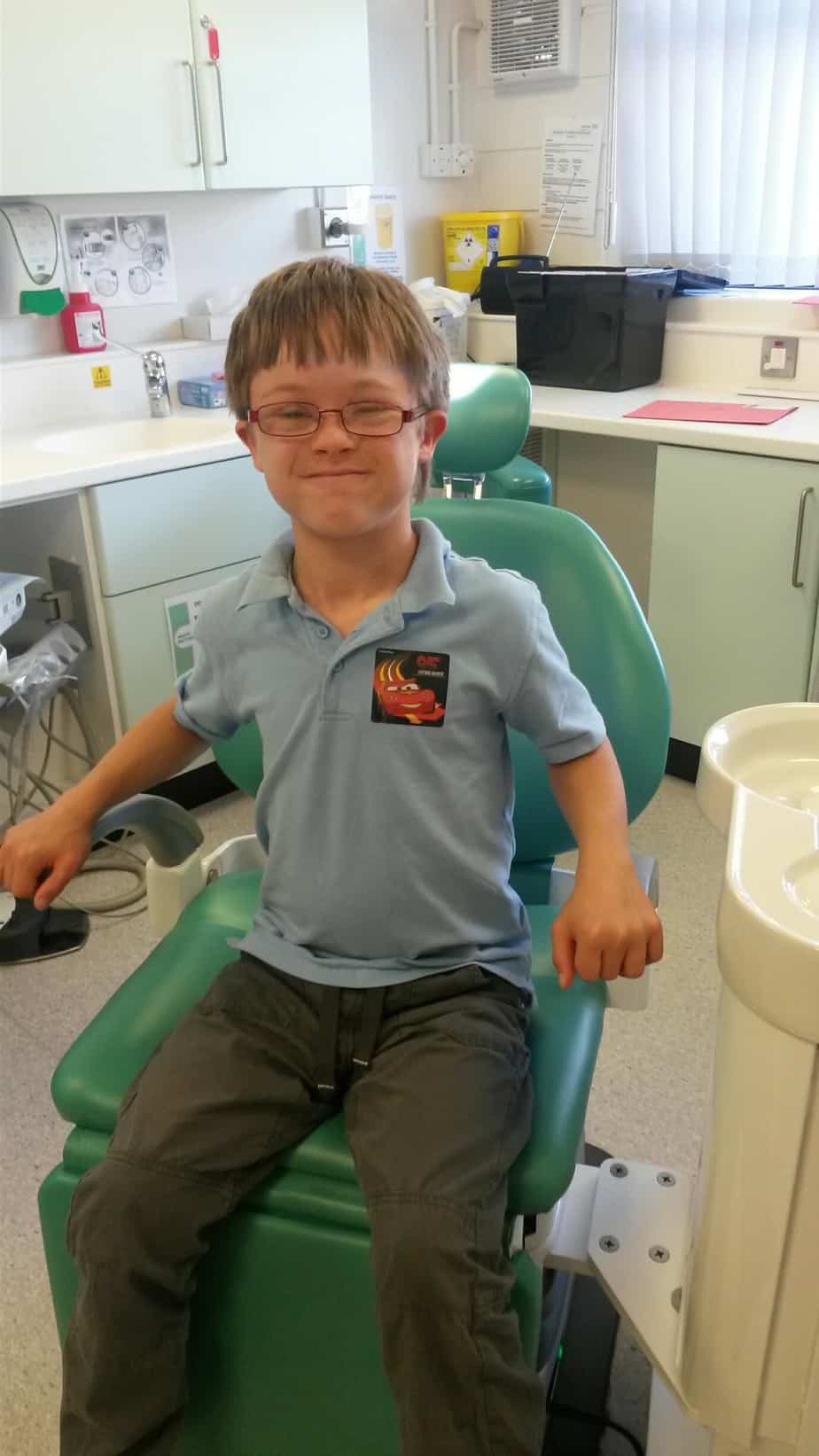
I think, and I fervently hope, we are on the edge of a revolution! Sensory Processing Difficulties have been hovering around on the edges of my special needs world for some time, but as none of the NHS therapists we see had ever raised any concerns, or in fact even raised the subject, I was happy to leave it as something other people needed to deal with.
That is until now!
I guess the trigger for me has been puberty (not mine I hasten to add, rather the early onset puberty of my 10 year old son!) George’s behaviour has been changing dramatically over the past 12 months and the various clever techniques we have employed over the years to get him to engage with the tasks he hated most have been rapidly falling by the wayside. Whereas once I had been proud to say there was nothing he couldn’t do if he tried, now I was forced to accept there was a whole raft of things he couldn’t even allow himself to try.
Things like we have been strapping him in his car seat in order to brush his teeth, we have employed a 4 person distraction technique combined with CBeebies and a chocolate button reward system to get his hair cut, he has even endured months of recurring eye infections because we just couldn’t get close enough to clean his face.
In response to me vocalising the increasing difficulties we were having a number of people around me started to mention Sensory Processing. The more I looked into it, the more I read, the more it made sense to me. George has always had food sensitivities. I remember so clearly that very first visit to preschool, he watched the plate of biscuits go around the table, as it approached him he began to tremble and outstretch his arm. He focussed on that biscuit and with a sudden movement reached out and grabbed it then, as if burned, he dropped it as quickly as he had taken it. He had clearly sensed the social pressure to take that biscuit and had really tried, but there was no way it was going anywhere near his mouth!
He has also always struggled with sudden sensory stimuli; from sudden noises to unexpected touch, he has always had a dramatic flinch reflex and become visibly distressed. Maybe this was the answer to why the vast majority of his self help skills particularly around the areas of dressing and washing were things he found so much harder than you might expect?
Sadly, even with a request from his paediatrician, we were unable to secure even a sensory profile from our NHS Occupational Therapists, so in desperation we found a local private clinic and paid for an assessment.
To say that day change my life would be an understatement. With links from poor proprioception and vestibular systems now being made to some of his fine and gross motor skills as well as the understanding that you can be both under sensitive and over sensitive within one sensory area, I was bombarded with real REASONS why George finds so many things indeterminably difficult.
The biggest area of learning for me was around INTEROCEPTION (please excuse the following laymans explanation) this is your body’s internal sense of feeling things; feeling hot or cold, feeling pain, feeling hunger and thirst, feeling the need to go to the toilet. I had no idea these things were even linked, but as the OT asked me question after question it became clear that none of these things are working properly for George. This is also when I started to cry. We have had so much help over the years, so many opinions on why toileting has been so difficult for George, but never a reason, yet, at last we had an answer.
The OT knew that I wanted to focus on George’s self help skills out of this assessment. As we were looking towards secondary school choices and transition and our longer term goals for him were becoming more important the barriers he faced in these basic areas were the ones we really felt we had to help him with. So with the results of all her questions and observations in mind she suggested we try some Therapeutic Listening.
Now here, once again, you will have to forgive my layman’s explanation, but basically speaking Therapeutic Listening tracks are music which have been altered at specific frequencies to tap into the brain in the same areas as those which regulate body functions and do things like organise behaviour. Simply put, the theory was that if we could find the track that worked for George we might be able to get him desensitised to things like hair cutting or face washing.
Incredibly it really was that straight forward! During the course of our assessment appointment George listened to the music and explored some vibrating massage toys that I would not usually have expected him to touch. That evening he allowed us to wash his face with no resistance. Within a week we were playing the music on the way to a haircut and he was then sitting in the chair with no restraint and allowing the hairdresser to do her thing. We carried on playing the track regularly and got braver and braver with our expectations. What became apparent really early on was that George was feeling calmed by the music.
Once we had started the track we would tell him what we wanted him to do. We would also give him a choice. One of the things I am told you tend to see in children with sensory processing difficulties is a need to obsessionally control situations. So by playing the tracks and then telling George what was coming we were also able to introduce an element he could control. For example, we are going to wash your hair, would you like to do it in the bath or in the shower? Or we are going to cut your finger nails, would you like mummy to do it or daddy to do it? The results have been mindblowing.
There are other tracks that might help us with other things – the help with sleep/resettling at night one I am VERY excited about! We are playing the track to him immediately before a stressful activity. Depending on how the child responds some may need to listen to the tracks less often but in a more controlled environment using modulated headphones. George seems to be doing well just listening off the app we now have on his Ipad. We don’t know how long it will last for, we may have to change tracks in the future to keep up the results.
We went last week for our follow up appointment and with us took a small photo diary that George had compiled. It included photographs of things George had never done before, things he couldn’t do before he had his music: sit in the dentist’s chair and let her count his teeth, sit on the sofa and let daddy cut his nails, have a haircut without anyone holding him down. There was even a video clip to show her of George washing his own face with a flannel whilst dancing along to his music!
I think we have been really lucky with George’s response to this music, but the changes are indisputable. Next we are looking at trampolining and spinning exercises to work on his vestibular and proprioceptive systems and all of a sudden the sky is our limit again!
I am Carole, mum to 2 children; one birth child and one adopted, both of whom have Downs syndrome. I am brand new to blogging on Me Too which is a little bit to do with my new job as an Adopter Champion for @PACTcharity but mostly just because I have always wanted to! We have just started seeing Elaine at Leap Childrens Therapy for her sensory integration expertise @LeapChildrens_T, or you can have a browse through their website: Leap Children’s Therapy
For further information on Sensory Processing Disorder, you might be interested to look through these posts:
Sensory Processing Disorder & Our Boy With Down Syndrome
Sensory Processing Disorder & Sensation Avoidance
Sensory Processing Disorder, Sensation Seeking & Antisocial Behaviour
Potty Training A Child Who Has Zero Interest
…and for advice on ‘How To Get The Most Out Of Therapy For Children’, you can read my guest post over on Jump! Parents How to Get The Most Out Of Therapy For Children
***
Do have a browse through our blog (crafts, parenting, recipes etc) and come and join us on Facebook for lots more! We’ve also have a lovely new Facebook Group called Christmas Traditions & Magic For Children so please come and join us there too!
To receive our blog posts, please sign up at the right hand side of this page or for Product or Christmas News and promotions from the International Elf Service, please sign up at the bottom of the page. This year’s series of Elfie’s Christmas Letters, a shorter set of letters from different elves from the North Pole and other fun products will be in the shop a little later. Don’t forget Elfie’s Birthday Letters are now available in the shop too!













I’m loving these sensory posts! They’re ever so interesting to read from thing you’re doing to then what’s working. Am pleased to see the power and influence of music is helping too! Thanks, as always, for linking up with us on the #bigfatlinky hope to see you there this week
I find it all VERY interesting I must say. I think our bodies are such an incredible machine and we probably don’t understand the half of it.
This is fascinating it really is, I am so interested in the power of music and look how successful it has been for your family! Great news. Thanks so much for your lovely comments on my blog and for linking up to #sundaystars x
Isn’t it? I’m hoping that Carole will write another guest post further on in her journey! I’m sharing your beautiful post on FB in a few days. It really touched me x
This is very interesting blog post! You could be describing my son as well. I intend on following up with theraputic listening to see if it can help my son! Would you mind tell us what app you are using on the ipad? Are they part of the theraputic listening program or are they just availble in the app store?
Thank you for posting this….Much appreciated!
Hi Linda – from Carole – the app is a generally available one, I downloaded it from iTunes, but you need an OT to tell you which one to use with your child for their specific diagnosis as there are lots of individual tracks on there.
Carole